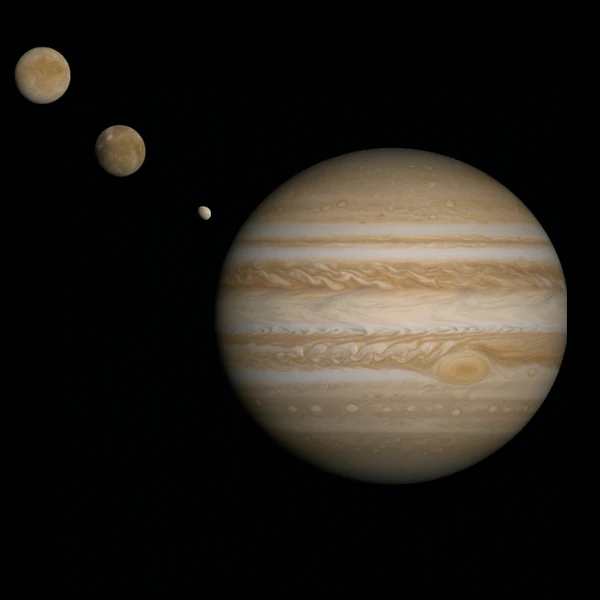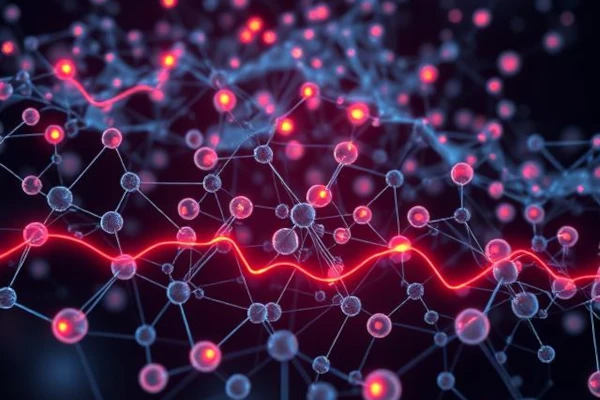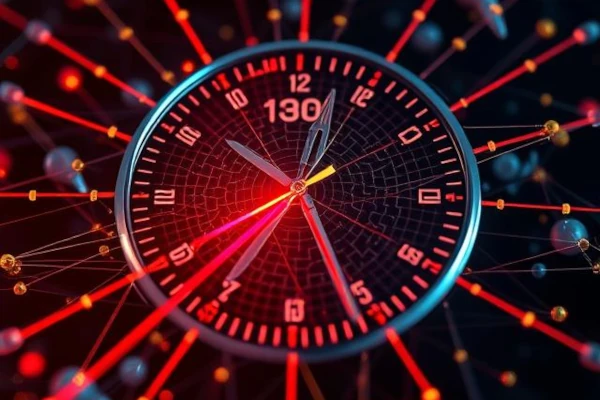
Spontaneous Synchronization is a fascinating phenomenon where complex systems, initially disordered or chaotic, gradually align to function in harmony without centralized control. This phenomenon emerges in various fields of physics, biology, animal behavior, and social sciences, revealing universal principles of self-organization.
In other words, spontaneous synchronization is a collective phenomenon in which a set of independent oscillating systems (moons, heartbeats, metronomes, fireflies, etc.) oscillate in a coordinated manner, without an external conductor imposing the rhythm.
This phenomenon, which might seem paradoxical in a universe dominated by entropy, is nonetheless ubiquitous, from the infinitely small to the infinitely large. It is rooted in the theories of nonlinear dynamic systems, where a weak but persistent interaction between elements can lead to a Global Order.
In the Jupiter system, the three Galilean moons Io, Europa, and Ganymede exhibit a remarkable 1:2:4 orbital resonance known as "Laplace resonance". For each complete orbit of Ganymede, Europa completes exactly two revolutions, and Io completes four. This perfect gravitational synchronization, discovered in 1805 by Pierre-Simon Laplace (1749-1827), maintains the long-term stability of their orbits despite their complex interactions.
Another remarkable example is the 1:2:4 resonance between the moons of Saturn: Mimas, Tethys, and Dione. Similar to the resonance of Jupiter's moons (Io, Europa, Ganymede), the mechanics at play are comparable: the moons exert tidal forces on each other, causing transfers of orbital energy. This interaction keeps them in a stable dynamic configuration while contributing to the internal heating of these bodies, notably through tidal friction.
Among the most spectacular cases is the coorbital system of Janus and Epimetheus, two moons of Saturn whose orbits are so close (about 50 km apart) that their trajectories seem to cross. However, through a mechanism of gravitational energy transfer, they exchange their orbits approximately every four years: the faster one moves to the slower orbit and vice versa. This occurs without collision, as their gravitational interaction induces a spontaneous synchronization of their trajectories. This celestial ballet is a perfect example of chaotic stabilization through interaction.

A classic demonstration of spontaneous synchronization involves several metronomes placed on a mobile platform, such as a suspended beam. Although initially set at different rhythms, the metronomes eventually synchronize perfectly due to the slight vibrations transmitted by the common platform. This mechanical phenomenon, popularized by the physicist Christiaan Huygens (1629-1695) in the 17th century, illustrates how coupled oscillating systems can spontaneously align.
The time required for the metronomes to synchronize depends on several factors, such as the mass of the platform, friction, and the amplitude of the vibrations. However, under ideal conditions, the metronomes generally synchronize within a few minutes.
The process is relatively quick due to the slight vibrations transmitted by the platform, which gradually adjust the rhythm of the metronomes until they beat in unison. The phenomenon can take from a few seconds to a few minutes, depending on the specific experimental conditions.

At the heart of cardiac function lies a remarkable phenomenon of spontaneous synchronization: the temporal alignment of action potentials among millions of cardiac muscle cells. These cells, although autonomous, synchronize to produce a Coherent Heartbeat. This coordination does not result from external control but emerges from an intrinsic biological network of electrophysiological couplings, ensuring a stable and efficient rhythm.
The time required for the spontaneous alignment of cardiac muscle cells depends on several factors, including tissue type, temperature, and physiological conditions. However, this phenomenon can occur very rapidly, within a few milliseconds to a few seconds.
When a group of cardiac muscle cells is initially desynchronized, action potentials propagate through electrophysiological connections (gap junctions), allowing rapid synchronization of the tissue. This speed is essential for proper heart function, as it enables coordinated and efficient contraction of the cardiac muscle with each beat.
The process is quite rapid due to the interconnection of cells via gap junctions, which allow almost instantaneous electrical transmission between cells.

In certain regions of Southeast Asia, thousands of male fireflies flash in unison, creating a hypnotic spectacle of synchronized light. This behavior, which maximizes reproductive chances, emerges without central coordination. Each firefly slightly adjusts its rhythm in response to the light signals of other fireflies.
This astonishing phenomenon, observed notably in Thailand, results from local interactions between individuals who gradually adjust their rhythm until they achieve perfect coordination at the colony level.
Modeled by the famous Kuramoto model, this system of weakly coupled oscillators demonstrates how local interaction can generate global synchronization.
The Kuramoto model is a mathematical model used to describe the synchronization of systems of coupled oscillators. It was proposed in 1975 by the physicist Yoshiki Kuramoto (1940-) to study how oscillators, initially desynchronized, can synchronize their behavior under the influence of mutual couplings.

In the field of complex network physics, interconnected atomic clocks can synchronize to provide ultra-precise time measurement.
Spontaneous Synchronization in the context of interconnected atomic clocks refers to the phenomenon where these clocks, despite their initially different natural frequencies, align without direct external intervention. This process occurs through interaction between the clocks, often via optical links and consensus algorithms that gradually adjust the phases of the clocks to bring them to a common frequency.
This synchronization emerges naturally, without the need for a central controller or an explicit external synchronization signal. The clocks autonomously adjust their rhythms to achieve precise synchronization through information exchange and mutual interactions, much like coupled oscillating systems in other spontaneous synchronization phenomena.
In certain stellar system configurations, such as binary pulsars, we observe a synchronization of radio emissions linked to their orbit. The gravitational interaction between the two stars results in a regulated dynamic, with relativistic tidal effects and energy dissipation via gravitational waves.
Pulsars emit radio waves at regular intervals. In a binary system, these emissions can synchronize with the pulsars' orbit, meaning their emission frequency can be affected and regulated by their orbital motion. This indicates that the radio emissions are in phase with the orbit, showing regularity linked to the system's dynamics.
The synchronization of radio emissions in binary pulsars is related to their gravitational interaction and the influence of general relativity, and this phenomenon serves as a means to observe and test the effects of extreme gravity in the universe.
Spontaneous synchronization illustrates how complex systems can generate global order from local interactions. Whether it involves fireflies, cardiac cells, atomic clocks, or pulsars, these dynamics show that apparent chaos often hides intrinsic organizational laws.